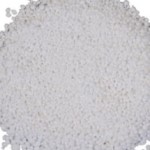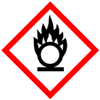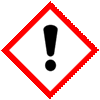CAS Number 7789-38-0 for NaBrO3, Sodium Bromate n Encapsulated Sodium Bromate Manufacturers Exporters








CAS Number 7789-38-0, Sodium Bromate Manufacturer Exporter
CAS Number NA, Encapsulated Sodium Bromate Manufacturer Exporter
For Properties Specifications of Sodium Bromate and Encapsulated Sodium Bromate Click Properties, Specifications of Sodium Bromate and Encapsulated Sodium Bromate Manufacturer.
For Uses of Sodium Bromate Click Uses of Sodium Bromate Manufacturer.
For For SDS MSDS Sheet of Sodium Bromate Click SDS Safety Data Sheet MSDS Sheet of Sodium Bromate Manufacturer.
The Properties and Specifications of Sodium Bromate and Encapsulated Sodium Bromate:
Specifications of Sodium bromate
Description = White and Crystalline powder.
Appearance of 20% Aqueous Solution = Clear and colorless
Assay (on dry basis) = >99.5%
pH of 5% Solution = 6-8%
Moisture by wt. = <0.5%
Chloride (as Cl) = <0.2%
Iron (Fe) = <0.001%
Heavy Metals (as Pb) = NIL
Insoluble matter % by weigh = <0.003.
Specifications of Encapsulated Sodium bromate
Active matter: 80% to 60% (as per low medium & heavy coating)
Mesh size: 15-40 mesh
Specific Gravity: Approximate 1.75.
Coated or Encapsulated Sodium Bromate based gel breaker is used for very high temperatures oil and gas fracturing. It will not be active up to 240F or 115C and is suggested for use at 280F to 330F or 138C to 165C. It can be offered as a quick release low-coated and slow release high coated material.
The Uses of Sodium Bromate:
Sodium Bromate is used in gold ore precessing, as an analytical reagent and boiler cleaner, and in hair preparations. It is widely used in oil and gas fracturing. Sodium bromate is mainly used in continuous or batch dyeing processes involving sulfur or vat dyes and as a hair-permagent, chemical agent, or gold solvent in gold mines when used with sodium bromide.
Coated or Encapsulated Sodium Bromate based gel breaker is used for very high temperatures oil and gas fracturing. It will not be active up to 240F or 115C and is suggested for use at 280F to 330F or 138C to 165C. It can be offered as a quick release low-coated and slow release high coated material.
The MSDS-SDS Hazard Statement of Sodium Bromate:
Sodium Bromate SDS, Safety Data Sheet
Material Safety Data Sheet 22-Jan-23
1. Product Identification
Product Name & Other Names: Sodium Bromate.
CAS No.: 7789-38-0
EINECS: EC Number: 232-160-4
Molecular Weight: 150.89
Chemical Formula: NaBrO3
Relevant uses and uses advised against (if any): Industrial Manufacturing.
2. Hazards Identification
GHS, Globally Harmonized System Classification in accordance with 29 CFR 1910
Classification according to Regulation (EC) No 1272/2008:
Oxidizing solids Category 2, H272
Acute Toxicity Oral Category 4, H302
Skin irritation Category 2, H315
Eye irritation Category 2A, H319
Specific target organ toxicity - single exposure Category 3, Respiratory system, H335
Labeling according to GHS & Regulation (EC) No 1272/2008
GHS Label Elements  Oxidizing Solid |
GHS Label Elements |
Signal Word: Danger
Hazard Statements:
H272: May intensify fire; oxidizer.
H302: Harmful if swallowed.
H315: Causes skin irritation.
H319: Causes serious eye irritation.
H335: May cause respiratory irritation.
Precautionary Statements
P210: Keep away from heat/sparks/open flames/hot surfaces – No smoking.
P220: Keep/Store away from clothing/…/combustible materials.
P221: Take any precaution to avoid mixing with combustibles.
P260: Do not breathe dust/fume/gas/mist/vapors/spray.
P270: Do not eat, drink or smoke when using this product.
P280: Wear protective gloves/protective clothing/eye protection/face protection.
P301+P312: IF SWALLOWED: Call a POISON CENTER or doctor/physician if you feel unwell.
P301+P330+P331: IF SWALLOWED: rinse mouth. Do NOT induce vomiting.
P302+P352: IF ON SKIN: Wash with soap and water.
P304+P340: IF INHALED: Remove victim to fresh air and keep at rest in a position comfortable for breathing.
P305+P351+P338: IF IN EYES: Rinse cautiously with water for several minutes. Remove contact lenses, if present and easy to do. Continue rinsing.
P332+P313: If skin irritation occurs: Get medical advice/attention.
P337+P313: If eye irritation persists: Get medical advice/ attention.
P342+P311: If experiencing respiratory symptoms: Call a POISON CENTER or doctor/physician.
3. Composition/Information on Ingredients
Product Name & Other Names: Sodium Bromate.
CAS No.: 7789-38-0
EINECS: EC Number: 232-160-4
4. First Aid Measures
Always seek medical attention after first aid measures are provided.
Inhalation: Remove to fresh air. If not breathing, give artificial respiration. If breathing is difficult, give oxygen. Get medical attention.
Ingestion: Never give anything by mouth to an unconscious person. Get medical attention.
Skin Contact: Wipe off excess material from skin then immediately flush skin with plenty of water for at least 15 minutes. Remove contaminated clothing and shoes. Get medical attention. Wash clothing before reuse. Thoroughly clean shoes before reuse.
Eye Contact: Immediately flush eyes with plenty of water for at least 15 minutes, lifting lower and upper eyelids occasionally. Get medical attention immediately.
5. Fire Fighting Measures
Flammability of the Product: The product is not flammable but it is an oxidizer.
Flash Points: NA.
Products of Combustion: It emits toxic oxides of sodium and hydrogen bromide or bromine.
Fire Extinguishing Media: Use water spray, alcohol-resistant foam, dry chemical or carbon dioxide. Use means suitable for extinguishing surrounding fire.
Special Information: In the event of a fire, wear full protective clothing and NIOSH-approved self-contained breathing apparatus with full face piece operated in the pressure demand or other positive pressure mode. At high temperatures under fire conditions, it may produce toxic or irritating fumes. Fire-extinguishing work is done from the windward and the suitable fire-extinguishing method according to the surrounding situation is used.
6. Accidental Release Measures
Personal precautions, protective equipment, and emergency procedures: Avoid breathing dust/fumes/gas/mist/vapors/spray. Use individual protective equipment (waterproof boots, suitable protective clothing, safety glasses, etc.). Do not approach facing the wind.
Environmental precautions: Do not let the product enter drains, soil, or water sources.
Methods and materials used for containment Cleanup procedures and Storage: Do not inhale vapors, mist, or gas. Avoid dust formation. Contain spilled material. Cover with an inert, non-combustible absorbent material, (e.g. sand, earth, diatomaceous earth, vermiculite). Use a shovel to put the material into a convenient waste disposal container. Finish cleaning by spreading water on the contaminated surface and allow to evacuate as per law.
7. Handling and Storage
Precautions for safe handling: Apply according to good manufacturing and industrial hygiene practices. Ensure proper ventilation. Wash thoroughly after handling. Do not drink, eat, or smoke while handling. Avoid contact with skin, eyes, and clothing. Minimize dust generation. Avoid breathing dust/fumes/gas/mist/vapors/spray. Keep container tightly closed. Avoid ingestion and inhalation. Use individual protective equipment (waterproof boots, suitable protective clothing, safety glasses, etc.).
Conditions for safe storage, including any incompatibilities: Store in cool, dry, and ventilated area away from heat sources and protected from sunlight in tightly closed original container. Keep air contact to a minimum. Do not leave the material container open. Store protected from heat, sparks and ignition sources and incompatible materials. Avoid contact with skin and eyes. Avoid inhalation of dust/mist/vapor. Do not store with incompatible materials like oxidizing material, reducing agents, powdered metals, alcohols, strong acids, and combustible substances.
8. Exposure Controls/Personal Protection
Airborne Exposure Limits: None established.
Ventilation System: A system of local and/or general exhaust is recommended to keep employee exposures as low as possible.
Personal Respirators (NIOSH Approved): For conditions of use where exposure to dust or mist is apparent and engineering controls are not feasible, a particulate respirator may be worn.
Skin Protection: Wear protective gloves and clean body-covering clothing.
Eye Protection: Use chemical safety goggles and/or full face shield where dusting or splashing of solutions is possible. Maintain eye wash fountain and quick-drench facilities in work area.
Other Control Measures: Maintain good housekeeping in work area. Handle in accordance with good industrial hygiene and safety practice.
9. Physical and Chemical Properties
Appearance: It is colorless or white crystals or powder or granules.
Odor: None to slight.
Odor threshold: Not available.
pH: 5-9 at 5% solution at 25 C (77F)
Relative density: 3.34.
Melting point/freezing point: Not available.
Boiling Point: Decomposes.
Flash point: Not available.
Auto-ignition temperature: Not available.
Decomposition temperature: Not available.
Upper/lower flammability or explosive limits: Not available.
Vapor pressure: Not available.
Vapor density: Not available.
Evaporation rate: Not available.
Flammability (solid, gas): Not available.
Partition coefficient: n-octanol/water: Not available.
Solubility: Readily soluble in water
Viscosity: Not available.
10. Stability and Reactivity
Stability: It is stable under ordinary conditions of use and storage.
Hazardous Decomposition Products: It emits toxic hydrogen bromide or bromine along with sodium oxide when heated to decomposition.
Hazardous Polymerization: Will not occur.
Incompatibilities: Strong reducing agents, Powdered metals, Alcohols, Strong acids.
Conditions to Avoid: Moisture, Heat, Incompatibles.
11. Toxicological Information
Toxicity to Animals:
LD50 Intraperitoneal - mouse - 140 mg/kg
Carcinogenicity: This product present at levels greater than or equal to 0.1% is identified as probable, possible or confirmed human carcinogen by IARC, NTP, ACGIH & OSHA.
Reproductive toxicity: No data available
Developmental Toxicity: Not available.
12. Ecological Information
Persistence and Degradability: No information available.
Mobility: No information available.
Bioaccumulation/ Accumulation: No information available.
Results of PBT and vPvB assessment: No data available for assessment.
Likely to be toxic to aquatic organisms, may cause long-term adverse effects in the aquatic environment. Do not empty into drains. Do not flush into surface water or sanitary sewer system. Do not allow material to contaminate ground water system.
13. Disposal Considerations
Whatever cannot be saved for recovery or recycling should be managed in an appropriate and approved waste disposal facility.
14. Transport Information
DOT USA, TDG Canada & ADR/RID Europe
UN-Number: UN1494 Class: 5.1 Packing group: II
Proper shipping name: Sodium bromate.
IMDG/IMO
UN-Number: UN1494 Class: 5.1 Packing group: II
Proper shipping name: Sodium bromate.
IATA
UN-Number: UN1494 Class: 5.1 Packing group: II
Proper shipping name: Sodium bromate.
15. Regulatory Information
USA:
SARA 311/312 Hazards: See section 2
California Prop 65: not listed.
Section 16 - Additional Information
Disclaimer:
**************************
Our company provides this Sodium Bromate SDS MSDS sheet in good faith but makes no representation as to its comprehensiveness or accuracy. This SDS sheet is intended only as a guide to the appropriate precautionary handling of the material by a properly trained person using this product. The above information has been compiled from various sources and has the possibility of discrepancy and being out-dated information. Individuals receiving the information must exercise their independent judgment and do further search in determining its appropriateness for a particular purpose. In no case shall our company be liable to loss or damages by the product user.
**************************
Anmol Chemicals & Pharmaceuticals Pvt. Ltd. is an off-shoot of Anmol Chemicals Taloja. It is located in MIDC Taloja and it is manufacturing pharmaceutical grades of API, Excepients, Food grade and Reagent grade chemicals. Anmol Chemicals & Pharmaceuticals Pvt. Ltd. is a several decades old group of companies, engaged in manufacturing, supplying, distributing, wholesale supplies for actual users, retail or small pack supplies for research and development chemicals, fine and speciality chemicals, pharmaceutical excipients, mineral fortifiers in chemically pure, Analytical reagent grade, IP BP USP Ph Eur EP JP and other pharmaceutical grade monograph including FCC Food grade chemicals and Nutraceuticals, Mineral Fortifiers at best prices.

Sodium Bromate Structure
CAS Number 7789-38-0 Sodium Bromate and Encapsulated Sodium Bromate Manufacturer Exporter
ANMOL CHEMICALS & PHARMACEUTICALS Pvt. Ltd.
India, USA, Europe, UAE
TELEPHONE: +912223770100
Navi Mumbai, INDIA
e-mail: info(At the rate i.e. @)anmol.org
Copyright. 24-nov-24
We manufacture:
Glacial Acetic Acid Manufacturer
Dihydroxyaluminum Sodium Carbonate
Ferric Chloride Anhydrous Hexahydrate
Light and Heavy Liquid Paraffin or Mineral Oil


